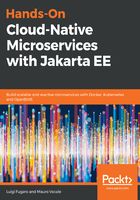
上QQ阅读APP看书,第一时间看更新
Build, release, run
The fifth factor is related to the first, second, and the third factors. It's about how a piece of code gets built, is released (packed), and runs in the target execution environment.
The preceding steps are called stages and represent the life cycle of your application. Each stage has its own specific role and isn't related to any other stage, and all together, these stages form a deployment.
So, to perform a deployment, we need the following:
- We need to build our source code pulled from a repository by identifying the code and its version. This is done by fetching dependencies and compiling the code (the first and second factors).
- To release the previous build, by identifying it by its name and version, we need to attach the appropriate configuration settings (the third factor). Every release has its own unique version (date, incrementing numbers, code name, and so on).
- To run the released build into the execution environment, we need to launch a process that grabs the previous release, by identifying it through name and version.
These stages can and should be performed by tools provided by the cloud platform. Tools such as Jenkins and GitLab continuous integration (CI) are great for such tasks. More details can be found in Chapter 9, Deployments.
Long story short, what you build is what you release is what you run.